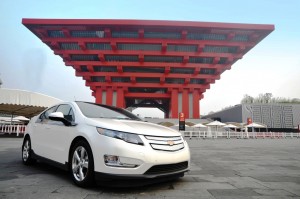With the Chinese, in general, increasingly willing to spend their money on potential Western bargains, the head of that country’s biggest domestic automaker today gave a clear signal that it is readying an investment in its U.S. partner, General Motors.
GM has been actively lining up investors for the IPO it is preparing – most likely for mid- to late-November. The maker has been courting traditional sources of cash, including large banks and investment firms, but it is also looking abroad. But one concern is whether a big investment by China in a company saved by U.S. taxpayer dollars will be politically acceptable.
“We are positive on GM, we believe the restructuring is very good for GM. We can see that it is moving to a healthy direction of development,” said Hu Maoyuan, Chairman of Shanghai-based SAIC Motor Corp.
SAIC has steadily expanded its partnership with General Motors since the U.S. maker began building Buicks at a joint venture plant a decade ago. In September, as GM began locking down details of its planned stock offering, SAIC reportedly reached out to its U.S. partner to see if there was interest in a Chinese investment.
“We will study and pay close attention to it, and yes, this is such a big IPO, and GM is moving to a very positive direction. I believe demand in the U.S. will pick up as the economy recovers,” the SAIC Chairman said during a Friday meeting with reporters.
Today, Buick is the single-largest brand in China, though it continues to battle it out with Volkswagen for overall supremacy in the world’s largest and fastest-growing national market. In the strange bedfellow world of the burgeoning Chinese auto industry, VW also has close ties with SAIC. And, to further complicate the situation, the Shanghai-based maker is pushing to become a major auto manufacturer under its own brand.
So, not surprisingly, General Motors has been cautious in its relations with SAIC despite the success of their 13-year relationship. Their joint venture plant in Shanghai, for example, is clean and efficient but is nowhere near as automated as some of the assembly lines GM operates on its own. And the U.S. maker is cautious about sharing some of its latest in-car technologies, as well.
But with SAIC as a big stakeholder, that might change, Huatai Securities analyst Chen Liang told the Reuter’s news service, suggesting, “An equity tie will bring the partnership to the next level and GM could possibly step up its technology input.”
Green technology could be a focus of such an expanded partnership. GM is planning to sell both its Chevrolet Volt and Opel Ampera extended-range electric vehicles in China, but as with the rest of the industry, SAIC is under pressure to market battery cars under its own name, as well.
During his news conference, SAIC’s Hu said he expects such vehicles to account for a full 20% of Chinese sales by 2015. SAIC and GM face challenges in the green space not only from the foreign-based joint ventures but from domestic wannabes, like BYD. Short for Build Your Dreams, the maker is pushing to use its standing as one of the world’s largest lithium-ion battery makers into a role as a major battery car producer.
Its ties with SAIC have been critical for GM which might not have been able to survive last year’s bankruptcy – even with a government bailout – without the solid growth it has been experiencing in emerging markets, notably China.
The partnership has been good for SAIC, as well. With the market still booming – though there are signs of a slight cool-down in demand – it expects to soon post profits that will boost net earnings for the first nine months of the year to 140% above last year’s levels.
While it is looking to China as a possible source of investment capital, GM is also reportedly exploring ties to various Mideast investors.
That’s no surprise if recent events are any indication. Kuwait has expanded its ties to a number of German automakers, including Daimler AG, and its investment funds now control British-based Aston Martin. Meanwhile, Chinese Zihang Geely Holding Group completed the purchase of Volvo from Ford Motor Co., over the summer. The company also owns one of those fast-growing domestic makers, Geely Automotive.
The big question is how such investments will fly with the White House — and taxpayers. It is currently unclear how much of its more than 60% stake the government will sell off as part of the GM IPO, though the Treasury has made it clear it wants to be out of the automotive business as soon as possible. But after spending over $50 billion to save GM — money that may not entirely be recouped in the IPO and subsequent stock sales — a hefty chunk of foreign cash could promote a backlash if it ultimately appears the American taxpayer did little more than save GM for foreign investors.
On the other hand, if foreign participation in the IPO helps drive up the price of GM stock, new investors like SAIC could get a warm welcome.


